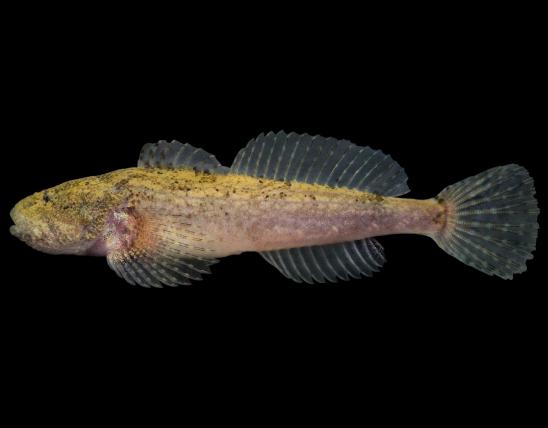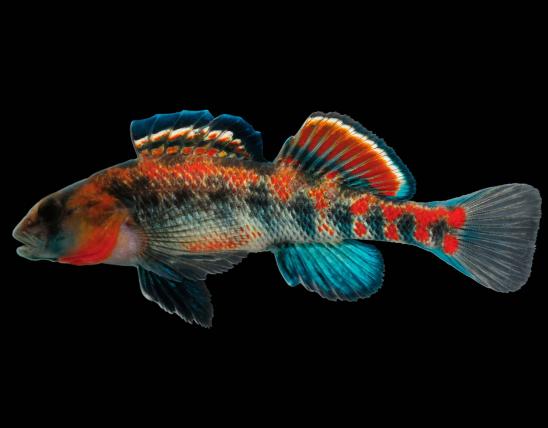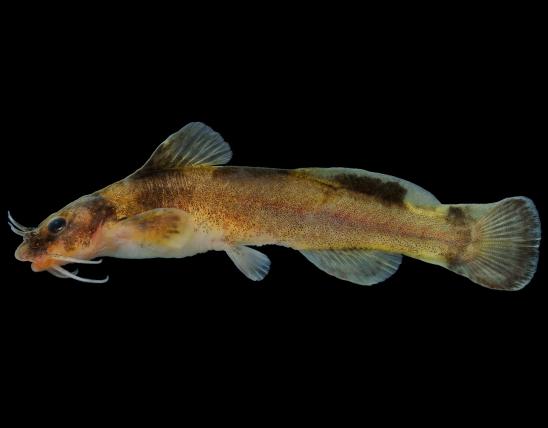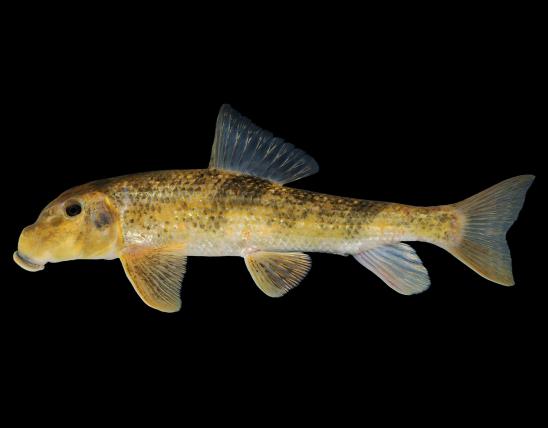
The Ozark sculpin was first described scientifically in 1985. Before that, it was considered synonymous with the mottled sculpin. Then, in 2010, researchers recognized the knobfin sculpin as a separate species and split it away from the Ozark sculpin. Among these fish, there are consistent differences in body form and in DNA. These indicate that what used to be considered “Ozark sculpins” occurring in the Current, Eleven Point, and White river drainages were a separate species, the knobfin sculpin.
Meanwhile, the Ozark sculpins in the Osage, Gasconade, and Black river drainages retain the name “Ozark sculpin.”
Sculpins, as a group, have very large mouths. The head is broad and flattened, tapering abruptly into the rather slender body. Scales are absent, but small prickles are often present on the head and body. The dorsal fin is divided into two distinct parts; the forward part contains spines, but these are soft and flexible, superficially resembling soft rays. The pectoral fins are large and fan-shaped. The pelvic fins each contain 1 stiff spine and 3 or 4 soft rays. The rear margin of the tail fin is rounded.
The Ozark sculpin can be distinguished from other Missouri sculpins by the following:
- The lateral line is incomplete, ending beneath the base of the soft dorsal fin.
- The two sections of the dorsal fin are clearly joined.
- There usually are wavy bands across the second dorsal fin, making it look marbled.
- Spawning males have a blue chin and belly.
- Dorsal fin spines number 6–7.
- Pectoral fin rays number 13–15.
- The membrane connecting the two sections of the dorsal fin is only slight to moderate-sized.
- There is moderate to strong pigmentation (dark markings) on the lower surface of the body cavity (you’d have to cut the fish’s belly open to see this).
- It occurs in the Osage, Gasconade, and Black river systems (not in the Current, Eleven Point, and White river systems).
Like our other sculpins, the overall color is variable, tending to match substrate color where found. The Ozark sculpin has the back and sides dusky and mottled, with the background color brown to olive. There are usually 4 (possibly 3–5) indistinct dark saddle marks across the back. A dark bar at the base of the tail fin is usually a thin crescent that is straight or slightly concave on its hind margin. Spawning males are dark grayish black to nearly black, with bluish-green color on the chin and belly, and a yellow to orange stripe on the outer edge of the first dorsal fin.
Similar species: Five species of sculpins occur in Missouri.
- The knobfin sculpin (C. immaculatus) is most similar. It too has an incomplete lateral line, clearly joined dorsal fins, wavy bands across the second dorsal fin, and breeding males with a blue-green chin and belly. However, it has a different dorsal fin spine count (8–9); has a different pectoral fin ray count (16–17); has a comparatively wide membrane connecting the two sections of the dorsal fin; and it has very little pigmentation in the lower surface of the body cavity. Also, the knobfin sculpin occurs in the Current, Eleven Point, and White river systems.
- The mottled sculpin (C. bairdii) occurs in the Osage, Gasconade, and Meramec systems, and in small tributaries to the Missouri and Mississippi rivers in the northern and eastern Ozarks. The mottled sculpin has a more rounded (less deep and compressed) body; the two sections of the dorsal fin are narrowly joined or are nearly separate; and spawning males are black, lacking blue coloration.
- The banded sculpin (C. carolinae) occurs in many of the same stream systems as the Ozark sculpin. Note the banded sculpin’s complete lateral line and its broad, distinct dark vertical bar at the base of the tail, angling forward toward the belly.
Habitat and Conservation
Sculpins, as a group, are bottom-dwelling fishes that lack a swim bladder. Their flattened bodies and enlarged pectoral fins are adaptations for maintaining a position in stream currents. They are able to modify their color to match their background and are difficult to see as they lie on the stream bottom.
The knobfin sculpin occurs in cool or cold spring-fed creeks and rivers with rocky bottoms, in the Ozarks of Missouri and Arkansas, in the Osage, Gasconade, and Black river systems. Knowing the geography is a good way identify this species.
Like the closely related knobfin sculpin, the Ozark sculpin can be the most abundant bottom-dwelling fish in Ozark spring branches and streams receiving much of their flow from springs.
This is one of more than 15 fish species that are endemic to the Ozarks of Missouri and Arkansas, occurring nowhere else in the world.
Food
Status
Abundant in the correct habitats and river systems.
Life Cycle
Spawning apparently occurs from early March through the end of April. Males excavate nest cavities beneath rocks and tend the eggs and fry until they disperse. Females enter the nest cavity and turn upside down to attach the eggs to the ceiling of the nest. It is likely that more than one female may spawn in the same nest. It is possible that spawning might begin as early as mid-December, as seems to be the case for the knobfin sculpin.
Human Connections
Prior to 2010, the Ozark and knobfin sculpins were considered a single species (called the Ozark sculpin), but it wasn’t long before that when the “Ozark sculpin” was considered the same as the mottled sculpin. The Ozark sculpin was split away from the mottled sculpin, and officially described, in 1985. Thus, references published before 1985 would lump all three species together as “the mottled sculpin.” The mottled sculpin, by the way, was described way back in 1850.
The species name, hypselurus, means “high tail,” and it refers to the depth of the hind part of the body.
Sculpins make interesting aquarium pets because of their bizarre appearance and ability to change color to match their background. However, they require live foods. Also, they prefer lower temperatures than most aquarium fish: the maximum they can tolerate is about 70 F. Nongame fishes may be collected for aquarium purposes by the holder of a fishing permit, using techniques and in numbers specified for bait collecting in the Wildlife Code of Missouri.
Ecosystem Connections
Ozark spring branches are busy places in springtime, as many species of fishes are breeding and many types of aquatic insects are becoming active. The impact that insect-eating fish have on populations of various types of flies must be considerable: they consume the immature stages of the insects before they have a chance to reproduce.
Advanced nest guarding and parental care is a reminder that the eggs and young of these fish are quite vulnerable to predation. Adults avoid predators with camouflage coloration and motionless behavior. Being larger and able to swim quickly away helps, too!































